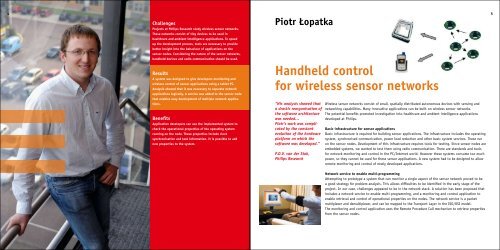Software Technology - Stan Ackermans Institute - TU/e
Software Technology - Stan Ackermans Institute - TU/e
Software Technology - Stan Ackermans Institute - TU/e
Create successful ePaper yourself
Turn your PDF publications into a flip-book with our unique Google optimized e-Paper software.
4<br />
Challenges<br />
Projects at Philips Research study wireless sensor networks.<br />
These networks consist of tiny devices to be used in<br />
healthcare and ambient intelligence applications. To speed<br />
up the development process, tools are necessary to provide<br />
better insight into the behaviour of applications on the<br />
sensor nodes. Considering the nature of the sensor networks,<br />
handheld devices and radio communication should be used.<br />
Results<br />
A system was designed to give developers monitoring and<br />
wireless control of sensor applications using a tablet PC.<br />
Analysis showed that it was necessary to separate network<br />
applications logically. A service was added to the sensor node<br />
that enables easy development of multiple network applica-<br />
tions.<br />
Benefits<br />
Application developers can use the implemented system to<br />
check the operational properties of the operating system<br />
running on the node. These properties include clock<br />
synchronisation and task information. It is possible to add<br />
new properties to the system.<br />
Piotr Łopatka<br />
Handheld control<br />
for wireless sensor networks<br />
“His analysis showed that<br />
a drastic reorganisation of<br />
the software architecture<br />
was needed…<br />
Piotr’s work was complicated<br />
by the constant<br />
evolution of the hardware<br />
platform on which the<br />
software was developed.”<br />
P.D.V. van der Stok,<br />
Philips Research<br />
Wireless sensor networks consist of small, spatially distributed autonomous devices with sensing and<br />
networking capabilities. Many innovative applications can be built on wireless sensor networks.<br />
The potential benefits promoted investigation into healthcare and ambient intelligence applications<br />
developed at Philips.<br />
Basic infrastructure for sensor applications<br />
Basic infrastructure is required for building sensor applications. The infrastructure includes the operating<br />
system, synchronised communication, power load reduction and other basic system services. These run<br />
on the sensor nodes. Development of this infrastructure requires tools for testing. Since sensor nodes are<br />
embedded systems, we wanted to test them using radio communication. There are standards and tools<br />
for network monitoring and control in the PC/Internet world. However these systems consume too much<br />
power, so they cannot be used for these sensor applications. A new system had to be designed to allow<br />
remote monitoring and control of newly developed applications.<br />
Network service to enable multi-programming<br />
Attempting to prototype a system that can monitor a single aspect of the sensor network proved to be<br />
a good strategy for problem analysis. This allows difficulties to be identified in the early stage of the<br />
project. In our case, challenges appeared to be in the network stack. A solution has been proposed that<br />
includes a network service to enable multi-programming, and a monitoring and control application to<br />
enable retrieval and control of operational properties on the nodes. The network service is a packet<br />
multiplexer and demultiplexer, and can be mapped to the Transport Layer in the ISO/OSI model.<br />
The monitoring and control application uses the Remote Procedure Call mechanism to retrieve properties<br />
from the sensor nodes.<br />
5



